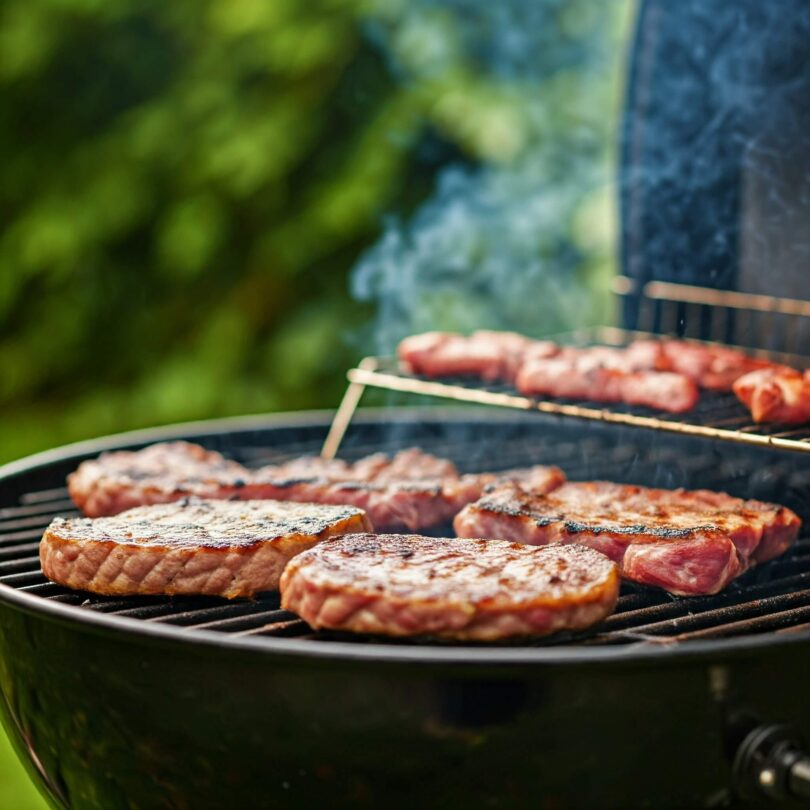BBQ and smoking are more than just cooking; they’re an art form, a science, and a way to bring people together. Whether you’re a backyard beginner or a seasoned pitmaster, these 10 tips and tricks will help elevate your BBQ game to the next level. Let’s dive deeper into each aspect to unlock the secrets of smoky, tender perfection.
1. Master Your Fire
The foundation of great BBQ starts with fire control. Whether you’re using charcoal, wood, or gas, understanding how to manage heat is critical.
- Charcoal: Learn the two-zone cooking method (direct and indirect zones). This setup gives you better control over cooking temperatures and prevents burning.
- Wood: Use hardwoods like oak, hickory, or fruitwoods for flavor. Avoid softwoods like pine—they burn too fast and release unpleasant resins.
- Pro Tip: Invest in a quality thermometer to monitor the grill’s internal temperature. Aim for low and slow (225°F–250°F) when smoking.
2. Choose the Right Cuts of Meat
Different cuts respond differently to BBQ and smoking techniques.
- Beef: Brisket, short ribs, and chuck roast shine in low-and-slow smoking.
- Pork: Go for pork shoulder (pulled pork) or spare ribs for tender, flavorful results.
- Poultry: Whole chickens and turkey absorb smoke quickly, so keep cook times shorter.
- Pro Tip: Look for cuts with good marbling—fat equals flavor.
3. The Magic of Marinades and Rubs
Flavor starts with your seasoning, whether it’s a dry rub, marinade, or brine.
- Dry Rubs: Mix spices like paprika, garlic powder, brown sugar, and cayenne for a perfect balance of sweet, spicy, and savory.
- Marinades: Use acidic bases (vinegar, citrus, or yogurt) to tenderize tougher cuts.
- Brining: Soak poultry or pork in a saltwater solution to lock in moisture. Add herbs or spices to the brine for extra depth.
- Pro Tip: Apply your rub at least 30 minutes before cooking—or even the night before—for maximum flavor.
4. Patience Pays: Low and Slow Cooking
BBQ is not about speed—it’s a slow dance between heat, smoke, and time.
- Cooking tough cuts like brisket requires hours at low temperatures to break down collagen and connective tissue.
- Avoid peeking too often; every time you open the lid, you lose heat and disrupt the process.
- Pro Tip: Use the “Texas crutch” (wrap the meat in foil or butcher paper midway through cooking) to retain moisture and accelerate the final stages.
5. Wood Smoke for Flavor
The type of wood you use impacts the flavor profile of your BBQ.
- Hickory: Bold and smoky, ideal for pork and ribs.
- Apple or Cherry: Sweet and mild, perfect for poultry and fish.
- Mesquite: Strong and earthy, great for beef but can overpower lighter meats.
- Pro Tip: Soak wood chips in water for 30 minutes before using to prevent them from burning too quickly.
6. Perfect Your Bark
The bark is that flavorful, crusty layer of seasoning on the outside of smoked meats—it’s the hallmark of great BBQ.
- Use a rub with a good balance of sugar, salt, and spices.
- Avoid wrapping the meat too early; give it time to develop a crust before using the Texas crutch.
- Pro Tip: Keep a consistent heat source and avoid opening the lid frequently to maintain airflow.
7. Resting Is Essential
Resting your meat after cooking is just as important as the cooking process itself.
- Let briskets and pork shoulders rest for at least 30–60 minutes in a cooler or wrapped in foil.
- This allows the juices to redistribute, making the meat more tender and juicy.
- Pro Tip: For smaller cuts, like ribs or chicken, 10–15 minutes of resting time will suffice.
8. Experiment with Sauces
While some purists skip sauce altogether, others love the additional flavor.
- Kansas City Style: Thick, sweet, and tangy. Perfect for ribs and pulled pork.
- Carolina Style: Vinegar-based with a touch of heat, ideal for pork.
- Texas Style: Tomato-heavy with a smoky kick—best for beef.
- Pro Tip: Apply sauce during the last 10–15 minutes of cooking to prevent burning. Serve extra on the side for dipping.
9. Invest in the Right Tools
The right tools can make all the difference.
- Thermometers: A good instant-read thermometer ensures meat is cooked to the right temperature.
- Smoker Box: For gas grill users, a smoker box can add authentic smoky flavor.
- Cleaning Tools: A sturdy grill brush keeps your grates in tip-top shape.
- Pro Tip: Don’t skimp on heat-resistant gloves—they’re a game-changer for handling hot meats and coals.
10. Practice Makes Perfect
BBQ is a skill that improves over time. Keep a BBQ journal to track:
- What cuts you used
- Cooking times and temperatures
- Types of wood and rubs
- Results and areas for improvement
- Pro Tip: Join BBQ communities online or in-person. Sharing tips and learning from others can inspire new techniques and recipes.
Final Thoughts
BBQ and smoking are about more than just cooking—they’re about the joy of creating something special. With these tips and tricks, you’ll be well on your way to mastering the art of BBQ. Remember, patience, practice, and passion are your best tools for success. Now, fire up that grill, and let the smoke roll!
What’s your go-to BBQ tip or trick? Let us know in the comments below!


Leave a Reply